In the iconoclastic Judson Dance Theater of the 1960s, visual artists Robert Rauschenberg, Alex Hay, and Robert Morris were among the choreographers and performers. The negotiations among them and their dance-world colleagues were boundlessly fruitful to both. In 1968, Yvonne Rainer wrote an essay titled “A Quasi Survey of Some ‘Minimalist’ Tendencies in the Quantitatively Minimal Dance Activity Midst the Plethora, or an Analysis of Trio A.”
That essay paired art objects and dances in terms of elements to be minimized or eliminated and followed that with a list of elements to be substituted for the ones above. Hence, the number 2 items in the top category were “hierarchal relation of parts” (the art object) and “development and climax” (the dance). To be substituted were “unitary forms, modules” and “equality of parts.” Given these values and the relationship between the two art forms, it seems entirely fitting that the monumental upriver gallery, Dia Beacon, would present three programs, spread over 2011 and 2012, that featured reconfigured revivals of Rainer’s early pieces along with her latest ones. In 2009-2010, Dia Beacon had produced a similar series of works by Trisha Brown, also a founding member of Judson Dance Theater.
Dia Beacon, a former printing factory for Nabisco, sits on a bluff above the Hudson River, a short uphill walk from the Metro North station. The two showings of Rainer’s last event took place on the afternoon of Sunday, May 3. In one of the cavernous Riggio Galleries, Rainer’s works looked especially pristine, the bright colors of the performers’ costumes like brushstrokes of color on the all-white surfaces.
On the program: We Shall Run (1963), Trio A (1966), Assisted Living: Good Sports 2 (2011), and Chair/Pillow (1969). The first is performed by a horde of Sarah Lawrence dance students (a mix of undergraduates and MFA candidates). The title sums it up: they run. But beyond that flat description, a lot transpires. For one thing, the group of 12 walks on and stands in a shoulder-to-shoulder line on the audience-left side of the space, facing the distant opposite wall. They’re wearing carefully selected casual clothing. The air of expectation is shattered by sound: the tremendous “Kyrie” from Hector Berlioz’s Requiem. No one moves. For a long, long time.
The recorded horns call out. The drums reinforce the summons. The voices sing out. Finally the dancers run—just your ordinary jogging. They run in a herd, in divergent clumps, in curving paths, in straight lines, in circles. They reverse directions. One person sets off on her own, then merges with an oncoming group. Their patterns have a logic, but not one that’s easily graspable. The music subsides into quietness. Ends. They stop.
I didn’t see We Shall Run in 1963, so I don’t know whether the audience responded to its formal proposition: the contrast between cool, minimally textured, underplayed action and rich, emotionally turbulent 19th-century sacred music. Watching it now, I find myself suddenly moved: the monumental music colors the running dancers as workaday members of the human race—not knowing where their paths may take them, but keeping on going anyway.
Trio A, originally performed by David Gordon, Steve Paxton, and Rainer, is a long, uninflected movement phrase with no repeats; it’s beautifully, imaginatively constructed, but performed without accompaniment in a kind of smooth physical monotone. The performers avert their gazes from the spectators for fear of seducing them by personality. The 1966 cast began together, but their individual senses of timing gradually moved them apart.
The 14 Sarah Lawrence dancers enter gradually —to begin as others finish— so they’re at different points in Trio A from the start. However, as your eyes scan the space, you begin to notice, say, two people who are now—perhaps briefly—in unison. You may be drawn to divining similarities or note how differently one person performs a movement from the way another did it a few seconds ago. The performing area looks like a white field filled with people executing private yet similar tasks.
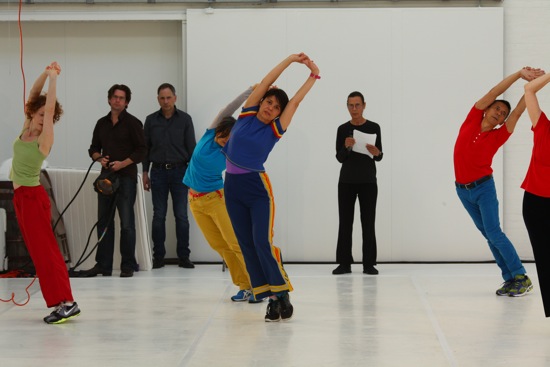
The Raindears in Assisted Living. (L to R.) Emily Coates, Emmanuèlle Phuon, Patricia Hoffbauer, Keith Sabado, and part of Pat Catterson. At back: Les Dickerson, Joel Reynolds, and Yvonne Rainer. Photo: Paula Court
Assisted Living: Good Sports 2 is performed by members of the group Rainer formed in 2005 not long after returning to dancemaking after a notable career as an independent filmmaker. The “Raindears” consist of relatively mature stellar dancers: Pat Catterson, Emily Coates (the baby of the bunch), Patricia Hoffbauer, Emmanuèlle Phuon, and Keith Sabado (a sixth original cast member, Sally Silvers, did not, alas, appear).
The atmosphere of the piece reminds me of the Grand Union, a group of stellar improvisers that grew out of Rainer’s company in the early 1970s, although I sense that much of Assisted Living is set. The brilliant performers are rambunctious and full of ideas. Rainer introduces them, strolls among them, and reads (sometimes on tape) from a slew of wide-ranging sources (one of which details the Ku Klux Klan’s invocation of the spurious Protocols of the Elders of Zion). She also tries to tell a joke about Steve Jobs, but neither she nor any of the others remembers the punch line. She also patiently pulls them, one by one, from a heap where they’ve fallen and are laughing uncontrollably. She spends some of the time watching from the back and helping lighting designer Les Dickerson and set designer Joel Reynolds gradually move an array of electrical equipment and objects (emblematic, I think, of past Rainer works) along the back of the gallery and down one of its sides to the front.
Snatches of music, largely garnered by Rainer and Quentin Chiappetta from 78 rpm records, drop occasionally into the proceedings. The performers do a lot of running and posing—the latter often in tableaux that suggest a ferocious fight caught by a still camera (Coates often arranges her face into a silent, lop-sided howl, as if hit with a hook to the jaw). They sing a few bars of favorite songs and spend quite a lot of time jogging around shaking their hands and responding to whatever command the leader-of-the moment calls out from an approved list (words like “jump” and “arms up,” as well as more fanciful ones). Some of the movement suggests sports, and although the performers have their separate bouts of activity, they’re a convivial bunch, ready to support a leaning colleague or carry him/her along. They’re so smart and so seriously funny that you’re in love with all of them before they’re done.
Rainer has constructed the rich stew of a piece so that movements echo or refer back to other movements, taking on new significance or coloring as they do so. She even brings up a variant of a remark she made when the complete piece was performed in March, 2011. Then she said, “Previously she wanted to be looked at and admired. Now she just wants to be admired.” At Dia, she abandons the faux-third-person mode and says, “I don’t want any more admiration. I just want money.”
For a finale, Rainer returns to one of her simplest, most imaginatively task-like pieces. Chair/ Pillow can involve any number of dancers—each armed with the afore-mentioned objects. In this case, the number of people onstage gradually accumulates, and finally the Raindears join the Sarah Lawrence people to repeat several times, mostly in unison, the short, neatly tailored sequence, while the taped voices of Ike and Tina Turner sing “River Deep—Mountain High.” The chairs face the audience, and so do the dancers most of the time, but the various bluntly performed arrangements of chair, pillow, and person create fine configurations in space.
Reading Rainer’s list of things deemed necessary to eliminate from art in the 1960s, I see that the last one in the object column is “monumentality,” balanced in the dance column by “the virtuosic movement feat and the fully-extended body.” In the list below, the desired substitute for both is “human scale.” In the course of investigating and honoring human scale, Rainer has, in several senses, redefined virtuosity.

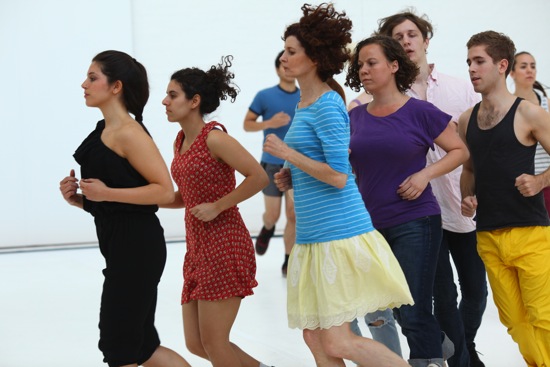
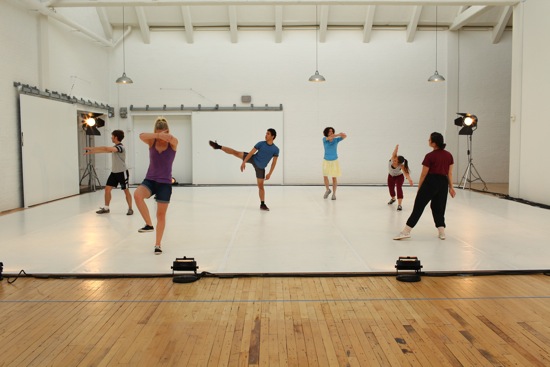
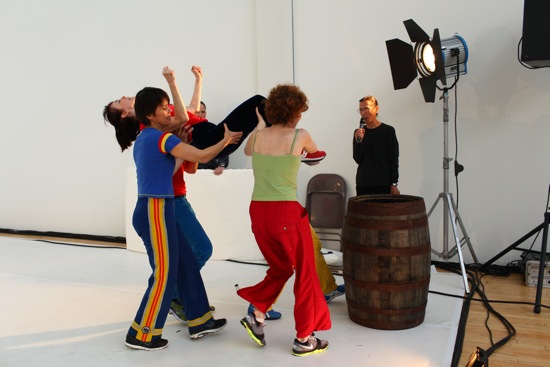
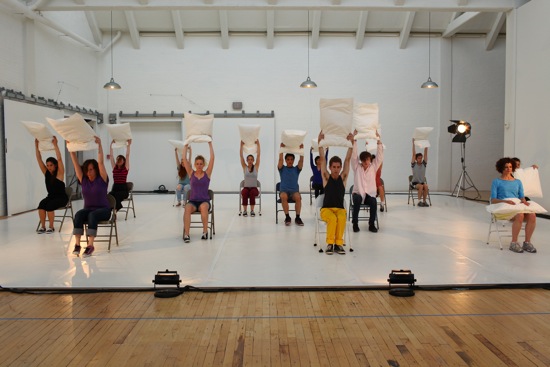
If this work redefines virtosity, it is perhaps due to the presence (I didn’t see this iteration of the work, but I know the players on stage, and I do know Dia:Beacon) of performers (the Raindeers) who have virtosity in abundance, technique to burn, and combined decades of stage presence. (They also happen to be beautiful, which never hurts. One would be happy to watch them brush their teeth.) Therefore denial is a specific act. (In other words, an unpointed foot which knows how to point is different from a foot which has never pointed. To dance in silence but to be musical….Etc.) I guess my point is that it takes a non-pedestrian to make pedestrian movement virtuosic. Thanks for this wonderful piece, Deborah.
I quite agree with Nancy on this point. In fact I believe the same is true for improvisation. Years of disciplined training combined with a daring willingness to “let go” are required and come to think of it, is the hallmark of great dancing even in Swan Lake.